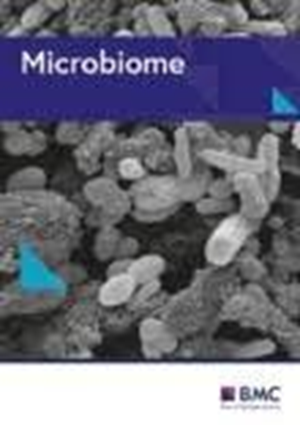古安第斯湖沉积物中嗜极细菌和古细菌遗传多样性和代谢能力的过度扩张
IF 13.8
1区 生物学
Q1 MICROBIOLOGY
引用次数: 0
摘要
安第斯高原上有许多高海拔湖泊,其生存条件十分恶劣。这些湖泊正经历着由当前气候引起的干涸过程,留下了暴露在极端大气条件下的阶地,可作为火星古湖泊盆地的类似物。人们对阿尔蒂普拉诺湖泊阶地的微生物组研究甚少,这些微生物组包含了一些未培养的品系,是了解环境适应性和地球生命极限的绝佳机会。在这里,我们研究了智利阿尔蒂普拉诺地区富含硫磺和金属/类金属的盐湖莱希亚湖(Laguna Lejía)阶地剖面的古沉积物(10.3-11 kyr BP(距今前))中的微生物多样性和功能。我们还通过研究阶地剖面的矿物学和地球化学,评估了该湖泊随着时间推移而发生的物理和化学变化。阶地剖面的矿物学和地球化学研究表明,该湖的水位波动较大,有机碳稀缺,SO42--S、Na、Cl 和 Mg 浓度较高。脂质生物标志物分析表明古沉积物中保存有水生/陆生植物遗迹,基因组分辨元基因组学揭示了一个多样化的原核生物群落,根据硅学生长预测,其中仍有活跃的微生物。我们重建了 591 个细菌和古细菌元基因组组装基因组(MAGs),其中 98.8% 属于以前未报道过的物种。MAGs中最丰富、最广泛的代谢是S、N、As和卤代化合物的还原和氧化,以及有氧CO氧化,这可能是有机碳贫乏沉积物中的一个关键代谢特征。系统发育上相距甚远的细菌和古细菌之间广泛的氧化还原和二氧化碳固定途径将代谢能力的知识扩展到了以前未知的类群。例如,我们发现了类杆菌属、α-和γ-蛋白细菌中异嗜硫酸盐还原的基因组潜力,预测了一种新型放线菌中的氨氧化酶,并预测了 Planctomycetota、Gemmatimonadota 和 Nanoarchaeota 中卡尔文-本森-巴塞尔循环的酶。莱吉亚湖的新型细菌和古细菌 MAGs 数量之多,表明所发现的原核生物具有广泛的多样性。此外,在意想不到的分类群中发现基因对扩大参与碳、氮和硫的生物地球化学循环的微生物范围具有重要意义。本文章由计算机程序翻译,如有差异,请以英文原文为准。
Hyperexpansion of genetic diversity and metabolic capacity of extremophilic bacteria and archaea in ancient Andean lake sediments
The Andean Altiplano hosts a repertoire of high-altitude lakes with harsh conditions for life. These lakes are undergoing a process of desiccation caused by the current climate, leaving terraces exposed to extreme atmospheric conditions and serving as analogs to Martian paleolake basins. Microbiomes in Altiplano lake terraces have been poorly studied, enclosing uncultured lineages and a great opportunity to understand environmental adaptation and the limits of life on Earth. Here we examine the microbial diversity and function in ancient sediments (10.3–11 kyr BP (before present)) from a terrace profile of Laguna Lejía, a sulfur- and metal/metalloid-rich saline lake in the Chilean Altiplano. We also evaluate the physical and chemical changes of the lake over time by studying the mineralogy and geochemistry of the terrace profile. The mineralogy and geochemistry of the terrace profile revealed large water level fluctuations in the lake, scarcity of organic carbon, and high concentration of SO42--S, Na, Cl and Mg. Lipid biomarker analysis indicated the presence of aquatic/terrestrial plant remnants preserved in the ancient sediments, and genome-resolved metagenomics unveiled a diverse prokaryotic community with still active microorganisms based on in silico growth predictions. We reconstructed 591 bacterial and archaeal metagenome-assembled genomes (MAGs), of which 98.8% belonged to previously unreported species. The most abundant and widespread metabolisms among MAGs were the reduction and oxidation of S, N, As, and halogenated compounds, as well as aerobic CO oxidation, possibly as a key metabolic trait in the organic carbon-depleted sediments. The broad redox and CO2 fixation pathways among phylogenetically distant bacteria and archaea extended the knowledge of metabolic capacities to previously unknown taxa. For instance, we identified genomic potential for dissimilatory sulfate reduction in Bacteroidota and α- and γ-Proteobacteria, predicted an enzyme for ammonia oxidation in a novel Actinobacteriota, and predicted enzymes of the Calvin–Benson–Bassham cycle in Planctomycetota, Gemmatimonadota, and Nanoarchaeota. The high number of novel bacterial and archaeal MAGs in the Laguna Lejía indicates the wide prokaryotic diversity discovered. In addition, the detection of genes in unexpected taxonomic groups has significant implications for the expansion of microorganisms involved in the biogeochemical cycles of carbon, nitrogen, and sulfur.
求助全文
通过发布文献求助,成功后即可免费获取论文全文。
去求助
来源期刊

Microbiome
MICROBIOLOGY-
CiteScore
21.90
自引率
2.60%
发文量
198
审稿时长
4 weeks
期刊介绍:
Microbiome is a journal that focuses on studies of microbiomes in humans, animals, plants, and the environment. It covers both natural and manipulated microbiomes, such as those in agriculture. The journal is interested in research that uses meta-omics approaches or novel bioinformatics tools and emphasizes the community/host interaction and structure-function relationship within the microbiome. Studies that go beyond descriptive omics surveys and include experimental or theoretical approaches will be considered for publication. The journal also encourages research that establishes cause and effect relationships and supports proposed microbiome functions. However, studies of individual microbial isolates/species without exploring their impact on the host or the complex microbiome structures and functions will not be considered for publication. Microbiome is indexed in BIOSIS, Current Contents, DOAJ, Embase, MEDLINE, PubMed, PubMed Central, and Science Citations Index Expanded.
 求助内容:
求助内容: 应助结果提醒方式:
应助结果提醒方式:


